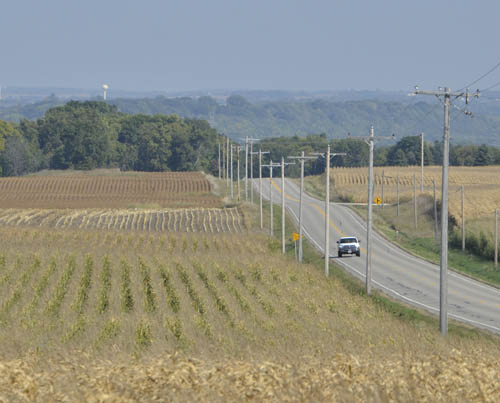Is sewage sludge incinerator ash from the Metro Wastewater Treatment Plant in Saint Paul a good phosphorus source for crop production?
The Metropolitan Council and University of Minnesota are embarking on a three-year partnership to find the answer.
Wastewater solids removed during treatment at the Metro Plant are incinerated in a process that recovers heat and generates electricity for the facility. The resulting ash, about 40 tons per day, is landfilled. The ash content is about 13% phosphorus.
Phosphorus used as crop fertilizer around the world
Phosphorus is a critical element for all organic life, and a key constituent of crop fertilizer worldwide, explained Christine Voigt, principal engineer at the Metro Plant. Phosphorus is currently mined from phosphate rock—primarily in Morocco. The expert consensus is that the quality and accessibility of currently available phosphate rock reserves are declining, and the costs to mine, refine, store and transport them are rising, according to the Earth Institute at Columbia University.
Between 1998 and 2007, staff at the Metro Plant successfully implemented biological phosphorus removal and reduced phosphorus in the water leaving the plant by 93%. That success means more phosphorus remains in the incinerated solids.
Meanwhile, wastewater coming into the Metro Plant contains a lot of phosphorus. Excessive phosphorus in rivers, lakes and streams causes algae growth and depletion of oxygen for fish and other water creatures; wastewater treatment plants in Minnesota are required to meet stringent standards to remove it during the treatment process.
Between 1998 and 2007, staff at the Metro Plant successfully implemented biological phosphorus removal and reduced the phosphorus content in the water leaving the plant by 93%. That success means more phosphorus in the remaining solids—which is why the solids ash may be valuable as a fertilizer, Voigt said.
Ash will be applied to cropland at university’s research center in Rosemount
 Researchers at the University of Minnesota will apply the ash on land at the U’s Rosemount Research and Outreach Center. Corn and soybeans will be grown for three years on the land. The study will evaluate:
Researchers at the University of Minnesota will apply the ash on land at the U’s Rosemount Research and Outreach Center. Corn and soybeans will be grown for three years on the land. The study will evaluate:
-
Corn and soybean growth
-
Phosphorus, metal concentrations, and microbial activity in the soil
-
Phosphorus and metal uptake by the plants
Recovering the nutrient from ash is more sustainable than landfilling it, Voigt said. The Metro Plant’s ash has the potential to fertilize 35,000 acres of land each year.
Council, industry efforts have reduced metals content of wastewater
Dr. Carl Rosen, professor at the U of M, said the land application of ash was also studied here in the early 1990s, but at that time the ash had a very high content of metals. A small greenhouse study at the University in 2015 showed that the ash now has a much lower metal content and that plants grown in the greenhouse did not have a large accumulation of metals, Rosen said.
Two decades ago, the solids ash had a much higher metal content because of industrial discharges. But recent industrial wastewater pretreatment efforts and the effectiveness of the Council’s industrial waste program have resulted in a 90% reduction of metals entering the Metro Plant and 70% less mercury, said Larry Rogacki, assistant general manager for Metropolitan Council Environmental Services.
Because the wastewater solids are incinerated, the ash does not contain any organic contaminants.
Phosphorus in ash would be cost-competitive, U researcher says
If proven viable for fertilizing crops, the ash would be cost-competitive with traditional fertilizers, Rosen said. In addition, the Council would no longer have to pay for landfilling the ash.
“What we want to do is shift the market to use some of our waste products instead of [having farmers] buying phosphorus from other places,” said Council Member Sandy Rummel, chair of the Council’s Environment Committee.
The Council will pay the University $605,000 over three years from the capital budget of the Environmental Services division.